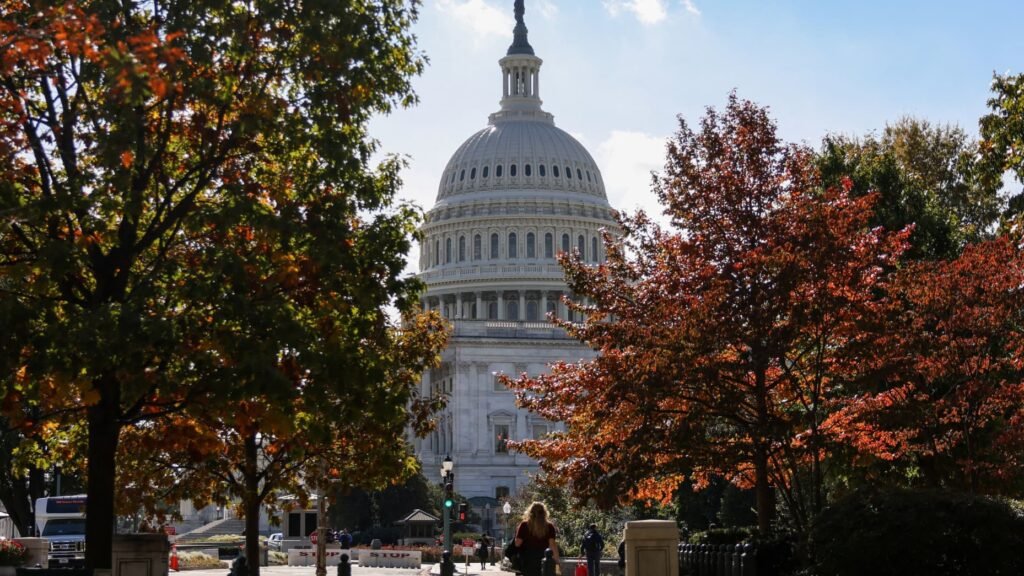- Open enrollment for health insurance offered via the Affordable Care Act marketplace starts Nov. 1 in most states.
- Prospective enrollees will likely see much higher premiums for health insurance.
- That’s largely because enhanced subsidies that lower insurance premiums are still in limbo amid the government shutdown.
- About 22 million of the 24 million ACA enrollees receive those enhanced premium tax credits.

The U.S. Capitol building, weeks into the continuing U.S. government shutdown, in Washington on Oct. 27, 2025.
Kylie Cooper | Reuters
Open enrollment for health insurance bought on the Affordable Care Act marketplace starts Nov. 1 in most states — but millions of people may get a financial surprise when they try to sign up.
That’s because a congressional deadlock tied to the extension of enhanced subsidies for insurance premiums has continued with no end in sight.
Consumers are “going to get huge sticker shock, because prices are going up,” said Carolyn McClanahan, a physician and certified financial planner based in Jacksonville, Florida.
That sticker shock could have significant ramifications for consumers’ finances and the choices they make about health coverage, experts say, contributing to a higher population of uninsured and underinsured consumers and soaring premiums in years to come.
While the percentage of Americans who have ACA marketplace health insurance is small, the share could be large enough to swing a close election, KFF reported in October.
ACA subsidies at the heart of the government shutdown
During open enrollment, consumers pick their health plans for the coming year.
While open enrollment generally lasts through Jan. 15, there’s a Dec. 15 deadline to ensure coverage starts at the beginning of 2026.
However, prospective enrollees are in financial limbo.
Congress has yet to extend the enhanced subsidies that make insurance premiums cheaper for about 22 million of the 24 million Americans who buy insurance over the ACA exchanges.
Recipients’ health premiums are set to increase by 114% in 2026, on average, without the enhanced subsidies, according to KFF, a nonpartisan health policy research group.
Certain enrollees, such as early retirees with modest incomes, face much larger increases, health experts said.
The enhanced subsidies are at the heart of the federal government shutdown that started Oct. 1. The shutdown is already the second-longest in U.S. history, behind a 35-day shutdown during President Donald Trump’s first term.
The enhanced subsidies, also known as enhanced premium tax credits, have been available since the Biden administration passed them in 2021 and extended them in 2022. They are scheduled to expire at the end of 2025.
Democrats are pushing to extend the subsidies as part of a deal to end the shutdown. Republicans have said they want to negotiate the subsidies separately.
What this means for open enrollment
Absent a deal, many people who try to enroll in a health plan via the Affordable Care Act marketplace will see significantly higher premiums during open enrollment, said Cynthia Cox, vice president and director of the ACA program at KFF.
The financial stakes vary according to factors such as household income, age and state.
For example, the average 60-year-old couple making $85,000 would see their annual premiums increase more than $22,600 in 2026, according to KFF.
A 45-year-old earning $20,000 in a state that didn’t expand Medicaid would see premiums rise from $0 to $420 per year, on average, it found.

There are many potential implications to the congressional impasse and consumers’ sticker shock during open enrollment, Cox said.
Many people may opt not to sign up for coverage rather than pay higher premiums, and therefore would be uninsured, Cox said.
Others, such as self-employed entrepreneurs and gig workers, may choose to try to find a more traditional job that offers employer-based health insurance so they don’t have to sign up for a marketplace plan, Cox said.
Some people may opt to buy lower-tier plans that come with smaller upfront premiums but much higher deductibles on the back end, meaning they’d be on the hook for a hefty bill if they need to use their insurance, Cox said.
What prospective ACA enrollees should do
As things stand, enhanced subsidies will expire.
Prospective enrollees in an ACA marketplace plan should pick their 2026 health insurance coverage with this in mind, Cox said. In other words, don’t pick a plan based on the expectation that Congress will extend the enhanced subsidies, she said.
However, she recommends enrollees pay close attention to the news. If Congress reaches a deal, enrollees should come back and look again, because their options and costs may have changed, Cox said.
“If it were me, I’d probably make a note on my calendar to shop over Thanksgiving or in early December,” with an eye to the Dec. 15 deadline, Cox said.










